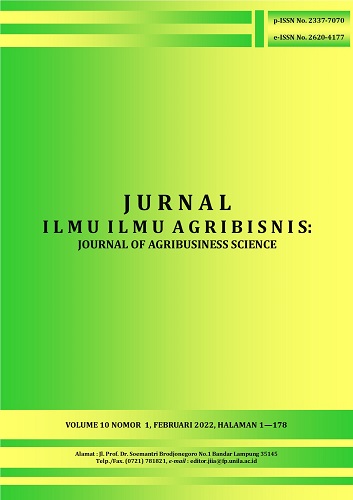ANALISIS PENDAPATAN DAN RISIKO USAHATANI JAGUNG DI KECAMATAN METRO KIBANG KABUPATEN LAMPUNG TIMUR
DOI:
https://doi.org/10.23960/jiia.v10i1.5648 Abstract View: 626
Abstract View: 626
Abstract
This study aims to examine the comparison of income, risk, risk mapping, and risk management strategies by farmersof corn farming in dry land and rainfed land. The survey was conducted in Metro Kibang District, East Lampung Regency in January 2021. The respondents were randomly selected as many as 70 farmers consisting of 40 dry land farmers in Margototo Village and 30 rainfed land farmers in Kibang Village. The data were analyzed using the income difference test, the coefficient of variation difference test, risk mapping, and descriptive analysis of farmers’ strategies. The results showed that the income of corn farming grown in dry land and in rainfed land was different, but both were profitable. The risk of production and income of corn farming in dry land is greater than in rainfed land. The risk mapping in dry land and rainfed land shows that the highest risk source come from pests. In general, dry land farmers and rainfed land farmers have similar strategies, i.e: doing replanting and spraying pesticides for controlling pests.
Key words: corn farming, income, risk, risk mapping
Downloads
Downloads
Published
How to Cite
Issue
Section
License
Authors who publish with this journal agree to the following terms:
Authors retain copyright and grant the journal right of first publication with the work simultaneously licensed under a Creative Commons Attribution License that allows others to share the work with an acknowledgement of the work's authorship and initial publication in this journal.
Authors are able to enter into separate, additional contractual arrangements for the non-exclusive distribution of the journal's published version of the work (e.g., post it to an institutional repository or publish it in a book), with an acknowledgement of its initial publication in this journal.
Authors are permitted and encouraged to post their work online (e.g., in institutional repositories or on their website) prior to and during the submission process, as it can lead to productive exchanges, as well as earlier and greater citation of published work (See The Effect of Open Access).














